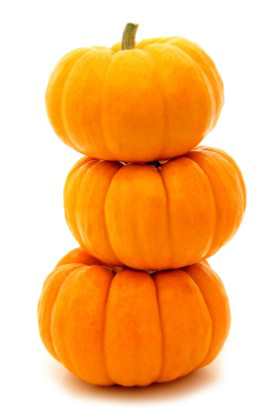
This image has format transparent PNG with resolution 280x419.
You can download this image in best resolution from this page and use it for design and web design.
Pumpkin PNG image with transparent background you can download for free, just click on download button.
A pumpkin is a cultivar of a squash plant, most commonly of Cucurbita pepo, that is round with smooth, slightly ribbed skin, and most often deep yellow to orange in coloration. The thick shell contains the seeds and pulp. Some exceptionally large cultivars of squash with similar appearance have also been derived from Cucurbita maxima. Specific cultivars of winter squash derived from other species, including C. argyrosperma and C. moschata, are also sometimes called "pumpkin".)
In 2017, world production of pumpkins (including squash and gourds) was 27 million tonnes, led by China with 29% of the total. Native to North America (northeastern Mexico and southern United States), pumpkins are one of the oldest domesticated plants, having been used as early as 7,500 to 5,000 BC. Pumpkins are widely grown for commercial use and are used both for food and recreation. Pumpkin pie, for instance, is a traditional part of Thanksgiving meals in Canada and the United States, and pumpkins are frequently carved as jack-o'-lanterns for decoration around Halloween, although commercially canned pumpkin purée and pumpkin pie fillings are usually made from different kinds of winter squash than the ones used for jack-o'-lanterns.
Pumpkins, like other squash, originated in northeastern Mexico and southern United States. The oldest evidence were pumpkin fragments dated between 7,000 and 5,500 BC found in Mexico. Pumpkin fruits are a type of botanical berry known as a pepo.
Traditional C. pepo pumpkins generally weigh between 3 and 8 kilograms (6 and 18 lb), though the largest cultivars (of the species C. maxima) regularly reach weights of over 34 kg (75 lb).
The color of pumpkins derives from orange carotenoid pigments, including beta-cryptoxanthin, alpha and beta carotene, all of which are provitamin A compounds converted to vitamin A in the body.
Pumpkins are grown all around the world for a variety of reasons ranging from agricultural purposes (such as animal feed) to commercial and ornamental sales.[12] Of the seven continents, only Antarctica is unable to produce pumpkins. The traditional American pumpkin used for jack-o-lanterns is the Connecticut Field variety.
In a 100-gram amount, raw pumpkin provides 110 kilojoules (26 kilocalories) of food energy and is an excellent source (20% or more the Daily Value, DV) of provitamin A beta-carotene and vitamin A (53% DV) (table). Vitamin C is present in moderate content (11% DV), but no other nutrients are in significant amounts (less than 10% DV, table). Pumpkin is 92% water, 6.5% carbohydrate, 0.1% fat and 1% protein (table).
Pumpkins are very versatile in their uses for cooking. Most parts of the pumpkin are edible, including the fleshy shell, the seeds, the leaves, and even the flowers. In the United States and Canada, pumpkin is a popular Halloween and Thanksgiving staple. Pumpkin purée is sometimes prepared and frozen for later use.
When ripe, the pumpkin can be boiled, steamed, or roasted. In its native North America, pumpkins are a very important, traditional part of the autumn harvest, eaten mashed and making its way into soups and purées. Often, it is made into pie, various kinds of which are a traditional staple of the Canadian and American Thanksgiving holidays. In Canada, Mexico, the United States, Europe and China, the seeds are often roasted and eaten as a snack.
Pumpkins that are still small and green may be eaten in the same way as squash or zucchini. In the Middle East, pumpkin is used for sweet dishes; a well-known sweet delicacy is called halawa yaqtin. In the Indian subcontinent, pumpkin is cooked with butter, sugar, and spices in a dish called kadu ka halwa. Pumpkin is used to make sambar in Udupi cuisine. In Guangxi province, China, the leaves of the pumpkin plant are consumed as a cooked vegetable or in soups. In Australia and New Zealand, pumpkin is often roasted in conjunction with other vegetables. In Japan, small pumpkins are served in savory dishes, including tempura. In Myanmar, pumpkins are used in both cooking and desserts (candied). The seeds are a popular sunflower seed substitute. In Thailand, small pumpkins are steamed with custard inside and served as a dessert. In Vietnam, pumpkins are commonly cooked in soups with pork or shrimp. In Italy, it can be used with cheeses as a savory stuffing for ravioli. Also, pumpkin can be used to flavor both alcoholic and nonalcoholic beverages.
In the southwestern United States and Mexico, pumpkin and squash flowers are a popular and widely available food item. They may be used to garnish dishes, and they may be dredged in a batter then fried in oil. Pumpkin leaves are a popular vegetable in the Western and central regions of Kenya; they are called seveve, and are an ingredient of mukimo, respectively, whereas the pumpkin itself is usually boiled or steamed. The seeds are popular with children who roast them on a pan before eating them. Pumpkin leaves are also eaten in Zambia, where they are called chibwabwa and are boiled and cooked with groundnut paste as a side dish.
Other than the traditionally defined pumpkin, commercially canned "pumpkin" purée and pumpkin pie fillings may contain other winter squashes, such as butternut squash.
In this gallery you can download free PNG images: Pumpkin PNG images free download